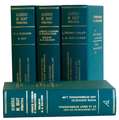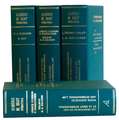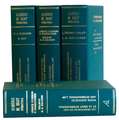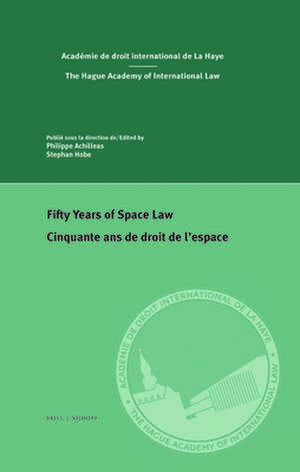Fifty Years of Space Law / Cinquante ans de droit de l’espace: Centre for Studies and Research in International Law and International Relations Series, cartea 21
Editat de Philippe Achilleas, Stephan Hobeen Limba Engleză Hardback – 10 dec 2020
Nous assistons à un nouvel âge d’or de la conquête spatiale. Durant la guerre froide, les États-Unis et l’Union soviétique avaient cherché à placer leurs exploits spatiaux dans le cadre du droit international. Aujourd’hui la tendance s’est inversée, la logique individualiste semble l’emporter. Certains grands principes du droit international de l’espace sont mis de côté ou réinterprétés par la pratique. Le juriste doit trouver ici un équilibre entre le développement des activités spatiales soutenu par des fonds privés et la prise en compte de l’intérêt de tous les Etats. Afin de répondre à ce défi, ce volume bilingue regroupe les travaux du Centre d’étude et de recherche de la session 2017. Deux approches scientifiques sont reflétées dans cet ouvrage. La première analyse les fondements et les grands principes du droit de l’espace depuis 1967, date de la signature du Traité de l’espace. La seconde propose une étude plus prospective pour determiner l’évolution du droit de l’espace dans les prochaines cinquante années. Ce volume permet de participer au rayonnement international d’une discipline peu connue et poser le cadre juridique des activités spatiales en développement.
Din seria Centre for Studies and Research in International Law and International Relations Series
- 18%
 Preț: 1048.04 lei
Preț: 1048.04 lei - 18%
 Preț: 1481.78 lei
Preț: 1481.78 lei - 15%
 Preț: 422.70 lei
Preț: 422.70 lei - 18%
 Preț: 1485.63 lei
Preț: 1485.63 lei - 18%
 Preț: 1479.48 lei
Preț: 1479.48 lei - 18%
 Preț: 1475.59 lei
Preț: 1475.59 lei - 15%
 Preț: 426.21 lei
Preț: 426.21 lei - 15%
 Preț: 420.37 lei
Preț: 420.37 lei - 15%
 Preț: 421.81 lei
Preț: 421.81 lei - 18%
 Preț: 1251.88 lei
Preț: 1251.88 lei - 18%
 Preț: 1254.98 lei
Preț: 1254.98 lei - 18%
 Preț: 1366.14 lei
Preț: 1366.14 lei - 18%
 Preț: 1253.69 lei
Preț: 1253.69 lei - 18%
 Preț: 1248.04 lei
Preț: 1248.04 lei - 18%
 Preț: 1256.56 lei
Preț: 1256.56 lei - 18%
 Preț: 1364.29 lei
Preț: 1364.29 lei - 18%
 Preț: 1363.35 lei
Preț: 1363.35 lei - 18%
 Preț: 1365.42 lei
Preț: 1365.42 lei - 18%
 Preț: 1478.32 lei
Preț: 1478.32 lei - 18%
 Preț: 1477.06 lei
Preț: 1477.06 lei - 18%
 Preț: 1475.21 lei
Preț: 1475.21 lei
Preț: 1259.23 lei
Preț vechi: 1535.65 lei
-18% Nou
Puncte Express: 1889
Preț estimativ în valută:
240.98€ • 253.45$ • 200.74£
240.98€ • 253.45$ • 200.74£
Carte indisponibilă temporar
Doresc să fiu notificat când acest titlu va fi disponibil:
Se trimite...
Preluare comenzi: 021 569.72.76
Specificații
ISBN-13: 9789004448056
ISBN-10: 9004448055
Greutate: 1.41 kg
Editura: Brill
Colecția Brill | Nijhoff
Seria Centre for Studies and Research in International Law and International Relations Series
ISBN-10: 9004448055
Greutate: 1.41 kg
Editura: Brill
Colecția Brill | Nijhoff
Seria Centre for Studies and Research in International Law and International Relations Series
Notă biografică
Philippe Achilleas, Professeur de droit public, Université Paris-Sud ; directeur de l’Institut du droit de l’espace et des télécommunications (Idest), Paris, et du Master spécialité Droit des activités spaciales et des télécommunications ; Chaire Droit des technologies et des services du futur.
Stephan Hobe, Holds a Jean Monnet Chair on Public International Law and European Law; Director of the Institute of Air, Space and CyberLaw at the University of Cologne.
Stephan Hobe, Holds a Jean Monnet Chair on Public International Law and European Law; Director of the Institute of Air, Space and CyberLaw at the University of Cologne.
Cuprins
Excerpt of Table of Contents:Introduction
Les rapports des directeurs d’études
Introduction
The Reports of the Directors of Studies
Chapter 1 – Chapitre 1
Le droit de l’espace
Section 1. Introduction : l’espace et son droit
Section 2. Une exploitation et une exploration de l’espace dans l’intérêt de tous les pays
Section 3. L’Etat au coeur du dispositif normatif
Chapter 2– Chapitre 2
50 Years of Space Law – Space Law in 50 Years
Section 1. Introduction
Section 2. The formative period of international space law – proximity to international air and maritime law
Section 3. The North-South Dichotomy – its influence on the formative period of space law. Is it still prevalent ?
Section 4. The shrinking normative value of space law-making
Section 5. Is space law a self-contained regime ?
Section 6. Will space law shift towards more private international law aspects ?
Section 7. Delimitation – is it really a problem ?
Section 8. The greatest challenge : Pollution of outer space through space debris
Section 9. Growing commercial uses of outer space : Gold rush with regard to resources from celestial bodies ?
Section 10. Space traffic management – a necessity for the time of future commercial uses of outer space
Section 11. Exploration of the universe as the unknown
Section 12. Conclusion
Part I
1967-2017 :
The 50 years of space law
The basics of international space law
Première partie
1967-2017 :
Les 50 ans du droit de l’espace
Les principes fondamentaux du droit international de l’espace
Chapter 3 – Chapitre 3
Les sources du droit de l’espace
Section 1. Introduction
Section 2. La diversification constante des sources du droit de l’espace : du droit de l’espace au droit spatial
Section 3. La recherche de la cohérence en matière spatiale : le droit de l’espace entre fragmentation et unite
Chapter 4 – Chapitre 4
The law of outer space : a self-contained regime ?
Section 1. Introduction
Section 2. From Special Rules to Self-Contained Regimes
Section 3. Analysis of the law of outer space as a special regime of international law
Section 4. Space law amidst the hierarchy and network of international law
Section 5. Avenues towards unity
Section 6. Conclusion
Chapter 5 – Chapitre 5
La guerre des étoiles : une perspective réaliste ?
Section 1. Introduction
Section 2. L’utilisation de l’espace à des fins pacifiques : une vision et ses défis
Section 3. La réglementation d’une guerre des étoiles potentielle
Section 4. Conclusions
Chapter 6 – Chapitre 6
International responsibility and liability of states in the conduct of space activities
Section 1. Introduction
Section 2. Current international legal framework
Section 3. Responsibility and liability for space activities
Section 4. The launching State, the registration State and the appropriate State
Section 5. Damage scope
Section 6. Collision of space objects in outer space
Section 7. Challenges arising from new types of damage
Section 8. Dispute settlement mechanism
Section 9. Future perspectives
Section 10. Conclusion
International space law for the utilization of outer space
Le droit international des utilisations de l’espace
Chapter 7 – Chapitre 7
Les télécommunications par satellite
Section 1. L’accès à la ressource spectre-orbite pour la mise en place d’un réseau de télécommunications par satellite
Section 2. Le cadre juridique propre aux acteurs conduisant des activités de télécommunications par satellite
Chapter 8 – Chapitre 8
Information via satellite : a human rights perspective
Section 1. Premise : rationale for the study and state of the art
Section 2. The influence of human rights theory and practice on international law
Section 3. Information via satellite in the new context of space activities : international and national perspectives
Section 4. Legal issues and practice related to flow of information
Section 5. Towards a universal approach concerning the balancing between information via satellite, state sovereignty and human rights ?
Chapter 9 – Chapitre 9
La télédétection par satellite : depuis des considérations juridiques historiques au rééquilibrage moderne
Section 1. Introduction
Section 2. Le cadre juridique clarifié autour de la liberté d’observation
Section 3. Le cadre juridique à réexaminer autour de la politique de données
Chapter 10 – Chapitre 10
Navigation by satellite
Section 1. Introduction
Section 2. Concept of satellite navigation. Global and regional satellite navigation systems
Section 3. Legal regime of satellite navigation
Section 4. Way forward
Section 5. Conclusions
Chapter 11 – Chapitre 11
Beyond earth orbit. space law and the exploration of the universe
Section 1. Introduction
Section 2. Geo-centricity. The utilitarian character of space law
Section 3. “Exploration”. A space law term explored
Section 4. Beyond earth orbit. The law of space exploration
Section 5. The undiscovered country. Space law in a new age of exploration
Part II
2017-2067 :
Space Law in 50 years
The legal frame for space programmes of tomorrow
Deuxième partie
2017-2067 :
Le droit de l’espace dans 50 ans
Le cadre juridique des programmes spatiaux de demain
Chapter 12 – Chapitre 12
Les véhicules spatiaux réutilisables
Section 1. Le véhicule spatial réutilisable : un objet, deux espaces
Section 2. Un vol dans l’air et dans l’espace : le vol aérospatial
Chapter 13 – Chapitre 13
The exploitation of natural resources on celestial bodies
Section 1. Introduction
Section 2. Legal Status of Natural Resources on Celestial Bodies
Section 3. Legal constraints under the principle of non-appropriation
Section 4. Space mining activities under the principle of non-appropriation
Section 5. Conclusion
Chapter 14 – Chapitre 14
The discovery of extraterrestrial life
Section 1. Law or science fiction ?
Section 2. Should there be a legal definition of extraterrestrial life ?
Section 3. The search for extraterrestrial life and how it should develop by 2067
Section 4. Beyond space law : intelligent extraterrestrials, relations with an extraterrestrial civilization and metalaw
Chapter 15 – Chapitre 15
Le droit de la colonisation spatiale
Section 1. Introduction
Section 2. La Fondation de colonies dans l’espace
Section 3. La perpétuation des colonies de l’espace
The legal framework for tomorrow’s space co-operation
Le cadre juridique de la coopération spatiale de demain
Chapter 16 – Chapitre 16
The legal requirements for the environmental protection of outer space : a truly global concern ?
Section 1. Introduction
Section 2. Environmental protection in (of) outer space : definitions and scope of research
Section 3. The legal status of outer space as a global common
Section 4. Applicability of international law
Section 5. Other instruments facilitating the protection of outer space environment
Section 6. Conclusion
Chapter 17 – Chapitre 17
Space traffic management – a new perspective for space law
Section 1. Introduction
Section 2. Definition of space traffic management
Section 3. Space traffic management in existing international instruments
Section 4. Other areas of international law relevant to space traffic management
Section 5. Conclusion : Towards a comprehensive international space traffic management system – A new perspective for space law ?
Chapter 18 – Chapitre 18
Le futur de la coopération spatiale internationale et régionale
Section 1. Introduction
Section 2. La coopération spatiale internationale : passé et present
Section 3. Conclusion
Chapter 19 – Chapitre 19
La coopération spatiale européenne : un modèle régional de cooperation spatiale ?
Section 1. L’Europe spatiale ou L’Hydre de Lerne
Section 2. La coopération spatiale européenne vers une modélisation régionale
Bibliography – Bibliographie
Les rapports des directeurs d’études
Introduction
The Reports of the Directors of Studies
Chapter 1 – Chapitre 1
Le droit de l’espace
Section 1. Introduction : l’espace et son droit
Section 2. Une exploitation et une exploration de l’espace dans l’intérêt de tous les pays
Section 3. L’Etat au coeur du dispositif normatif
Chapter 2– Chapitre 2
50 Years of Space Law – Space Law in 50 Years
Section 1. Introduction
Section 2. The formative period of international space law – proximity to international air and maritime law
Section 3. The North-South Dichotomy – its influence on the formative period of space law. Is it still prevalent ?
Section 4. The shrinking normative value of space law-making
Section 5. Is space law a self-contained regime ?
Section 6. Will space law shift towards more private international law aspects ?
Section 7. Delimitation – is it really a problem ?
Section 8. The greatest challenge : Pollution of outer space through space debris
Section 9. Growing commercial uses of outer space : Gold rush with regard to resources from celestial bodies ?
Section 10. Space traffic management – a necessity for the time of future commercial uses of outer space
Section 11. Exploration of the universe as the unknown
Section 12. Conclusion
Part I
1967-2017 :
The 50 years of space law
The basics of international space law
Première partie
1967-2017 :
Les 50 ans du droit de l’espace
Les principes fondamentaux du droit international de l’espace
Chapter 3 – Chapitre 3
Les sources du droit de l’espace
Section 1. Introduction
Section 2. La diversification constante des sources du droit de l’espace : du droit de l’espace au droit spatial
Section 3. La recherche de la cohérence en matière spatiale : le droit de l’espace entre fragmentation et unite
Chapter 4 – Chapitre 4
The law of outer space : a self-contained regime ?
Section 1. Introduction
Section 2. From Special Rules to Self-Contained Regimes
Section 3. Analysis of the law of outer space as a special regime of international law
Section 4. Space law amidst the hierarchy and network of international law
Section 5. Avenues towards unity
Section 6. Conclusion
Chapter 5 – Chapitre 5
La guerre des étoiles : une perspective réaliste ?
Section 1. Introduction
Section 2. L’utilisation de l’espace à des fins pacifiques : une vision et ses défis
Section 3. La réglementation d’une guerre des étoiles potentielle
Section 4. Conclusions
Chapter 6 – Chapitre 6
International responsibility and liability of states in the conduct of space activities
Section 1. Introduction
Section 2. Current international legal framework
Section 3. Responsibility and liability for space activities
Section 4. The launching State, the registration State and the appropriate State
Section 5. Damage scope
Section 6. Collision of space objects in outer space
Section 7. Challenges arising from new types of damage
Section 8. Dispute settlement mechanism
Section 9. Future perspectives
Section 10. Conclusion
International space law for the utilization of outer space
Le droit international des utilisations de l’espace
Chapter 7 – Chapitre 7
Les télécommunications par satellite
Section 1. L’accès à la ressource spectre-orbite pour la mise en place d’un réseau de télécommunications par satellite
Section 2. Le cadre juridique propre aux acteurs conduisant des activités de télécommunications par satellite
Chapter 8 – Chapitre 8
Information via satellite : a human rights perspective
Section 1. Premise : rationale for the study and state of the art
Section 2. The influence of human rights theory and practice on international law
Section 3. Information via satellite in the new context of space activities : international and national perspectives
Section 4. Legal issues and practice related to flow of information
Section 5. Towards a universal approach concerning the balancing between information via satellite, state sovereignty and human rights ?
Chapter 9 – Chapitre 9
La télédétection par satellite : depuis des considérations juridiques historiques au rééquilibrage moderne
Section 1. Introduction
Section 2. Le cadre juridique clarifié autour de la liberté d’observation
Section 3. Le cadre juridique à réexaminer autour de la politique de données
Chapter 10 – Chapitre 10
Navigation by satellite
Section 1. Introduction
Section 2. Concept of satellite navigation. Global and regional satellite navigation systems
Section 3. Legal regime of satellite navigation
Section 4. Way forward
Section 5. Conclusions
Chapter 11 – Chapitre 11
Beyond earth orbit. space law and the exploration of the universe
Section 1. Introduction
Section 2. Geo-centricity. The utilitarian character of space law
Section 3. “Exploration”. A space law term explored
Section 4. Beyond earth orbit. The law of space exploration
Section 5. The undiscovered country. Space law in a new age of exploration
Part II
2017-2067 :
Space Law in 50 years
The legal frame for space programmes of tomorrow
Deuxième partie
2017-2067 :
Le droit de l’espace dans 50 ans
Le cadre juridique des programmes spatiaux de demain
Chapter 12 – Chapitre 12
Les véhicules spatiaux réutilisables
Section 1. Le véhicule spatial réutilisable : un objet, deux espaces
Section 2. Un vol dans l’air et dans l’espace : le vol aérospatial
Chapter 13 – Chapitre 13
The exploitation of natural resources on celestial bodies
Section 1. Introduction
Section 2. Legal Status of Natural Resources on Celestial Bodies
Section 3. Legal constraints under the principle of non-appropriation
Section 4. Space mining activities under the principle of non-appropriation
Section 5. Conclusion
Chapter 14 – Chapitre 14
The discovery of extraterrestrial life
Section 1. Law or science fiction ?
Section 2. Should there be a legal definition of extraterrestrial life ?
Section 3. The search for extraterrestrial life and how it should develop by 2067
Section 4. Beyond space law : intelligent extraterrestrials, relations with an extraterrestrial civilization and metalaw
Chapter 15 – Chapitre 15
Le droit de la colonisation spatiale
Section 1. Introduction
Section 2. La Fondation de colonies dans l’espace
Section 3. La perpétuation des colonies de l’espace
The legal framework for tomorrow’s space co-operation
Le cadre juridique de la coopération spatiale de demain
Chapter 16 – Chapitre 16
The legal requirements for the environmental protection of outer space : a truly global concern ?
Section 1. Introduction
Section 2. Environmental protection in (of) outer space : definitions and scope of research
Section 3. The legal status of outer space as a global common
Section 4. Applicability of international law
Section 5. Other instruments facilitating the protection of outer space environment
Section 6. Conclusion
Chapter 17 – Chapitre 17
Space traffic management – a new perspective for space law
Section 1. Introduction
Section 2. Definition of space traffic management
Section 3. Space traffic management in existing international instruments
Section 4. Other areas of international law relevant to space traffic management
Section 5. Conclusion : Towards a comprehensive international space traffic management system – A new perspective for space law ?
Chapter 18 – Chapitre 18
Le futur de la coopération spatiale internationale et régionale
Section 1. Introduction
Section 2. La coopération spatiale internationale : passé et present
Section 3. Conclusion
Chapter 19 – Chapitre 19
La coopération spatiale européenne : un modèle régional de cooperation spatiale ?
Section 1. L’Europe spatiale ou L’Hydre de Lerne
Section 2. La coopération spatiale européenne vers une modélisation régionale
Bibliography – Bibliographie
